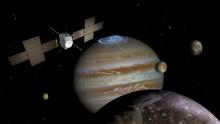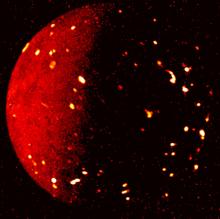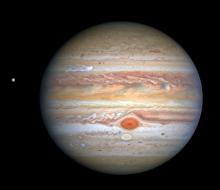Listen to today's episode of StarDate on the web the same day it airs in high-quality streaming audio without any extra ads or announcements. Choose a $8 one-month pass, or listen every day for a year for just $30.
You are here
Moon and Jupiter
The surface of Earth is constantly changing. On small scales, the changes are caused by wind, rain, and flowing water. On a large scale, though, they’re caused by the motions of Earth’s crust. New crust is created on the ocean floor, where molten rock pushes up from the mantle, the layer below the crust. And old crust disappears as one plate plunges below another, pushing its rock back into the mantle.
A similar process may be at work on Europa, one of the big moons of Jupiter. In that case, though, the plates are made of ice.
Europa’s crust consists of frozen water, with smatterings of minerals mixed in. That crust probably sits atop a global ocean of liquid water that could be miles deep. Geothermal vents at the bottom of that ocean could pump hot, mineral-rich water into the ocean. That would provide the energy and chemistry needed for possible life.
A recent study says that additional support for life could come from the motions of the plates of ice that make up the crust. Water bubbling through cracks in the ice could deposit minerals on the surface, making a plate denser and heavier. That could make the plate plunge beneath another. Some of its ice would melt, adding important nutrients to the ocean — a possible home for life in the outer solar system.
And Jupiter is in great view at first light tomorrow. It’s to the lower left of the Moon, and looks like a brilliant star.
We’ll talk about the Moon and another planet tomorrow.
Script by Damond Benningfield





